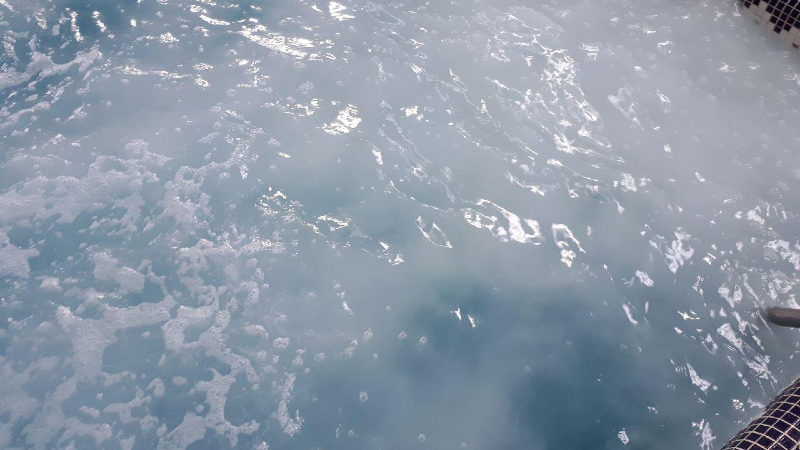- Home
- Troubleshooting
- Pool Foam
What Causes Pool Foam and How To Get Rid of It
Sometimes you expect to see bubbles in your pool. Maybe there's a return side leak and it's allowing air into the system. Or perhaps the O-ring on the pump pot lid is bad and needs replacing. Easy fixes, right? But what happens when the bubbles get to be too much. They start to accumulate to the point you're convinced someone poured laundry detergent into your pool?
Then you have a problem called pool foam. It's easy to find out why and even easier to fix.

How Do I Get Rid Of Pool Foam?
Well, first we need to look at the root cause of the problem. Chemicals that are not correctly balanced, improper filtration, leaks in the suction or return sides, and high levels of organic contaminants can all contribute to pool foam. Sometimes shocking the pool will solve your problem. If not, balancing your water chemistry is might what you need to do and is an easy fix.
What Is Pool Foam?
Pool foam can make the water feel thick. It might feel thick because it actually is thick. This thickness creates bubbles. Normal air bubbles easily pop and are common in pools. Foam in your pool usually means there's higher than normal organic material in your water.
What Causes Pool Foam?
Even the best pool owner can sometimes get pool foam, and it can come in a variety of ways.
Soap and Laundry Detergents
Of course this would be the first one. Maybe you have hard water and your washing machine cannot rinse out all the soap out of your bathing suits. Or the soap you're using to shower with is not being rinsed off. You wear clothes that have dried detergent residue. The residue gets on your body and then you go in the pool, and guess what happens? That's right. Dried detergent residue gets in the pool.
Toiletries
Think of everything people use: hairspray, make-up, deodorant, and lotions. The list could be endless. Couple those with multiple swimmers and your pool water could easily foam up.
High Bather Load
When I was the pool operator at the YMCA in Oregon, we had morning aquatic exercise classes. I would instruct the lifeguards to make sure no one enters the pool area without first taking a hot soapy shower. Many times this didn't happen. The patrons would enter the pool after slathering themselves down with lotions and oils. Sometimes there would be 70 - 80 people in the pool. All those people with all those oils and lotions would not only temporarily foam the pool water up, it would eventually decrease the sand filter's capacity to filter properly.
Pool Chemical Problems
So maybe the pool water isn’t properly balanced. Maybe you wanted to save a little money and unintentionally bought low quality pool chemicals. Either way, you could end up with a foamy pool.
Algaecide
I see this one all the time. Low quality or copper based algaecides can definitely cause foamy pool water. If your pool water foams up due to using a copper algaecide, your best bet is to scoop out as much foam as you can with a wide-mouth leaf rake and allow the filter to run 24/7 and backwash every few days until the water clears. Unfortunately, there's no chemical to counteract an algaecide overdose. After the water clears, only use a PolyQuat 60 algaecide.
How To Prevent Foamy Pool Water
Prevention is the key. An ounce of prevention is worth a pound of cure. There are some easy ways to fix and prevent your foamy pool water that doesn't require much money. It might take some time, but it'll be worth it in the long run.
Shock Your Pool
This is probably the easiest thing you can do, and many times the most effective. High doses of chlorine can break down the foam so it can dissipate and get filtered out. When in doubt, shock it out!!
Keep The Pool Water Balanced
By maintaining the proper pool chemistry, you'll be ahead of the curve. Keep your chlorine level at 2 - 4 ppm, pH between 7.2 - 7.8, alkalinity should be 80 - 120 ppm, hardness is good at 150 - 250 ppm, and the CYA is 30 - 50 ppm. I used and recommend the Taylor K-2006 test kit.
Shower Before Swimming
Taking a hot soapy shower before swimming will help reduce the chances of pool foam. Also, try fragrance free and low-suds detergents and soaps. You might want skip the fabric softener a few times to see if it helps.
Use A Good Algaecide
Using a quality PolyQuat 60 algaecide can go a long way in preventing pool foam. Copper algaecides are not needed and should never be used if you fill your pool with well water. If you use a pool start-up kit, check to see if it contains a copper algaecide.
Zero Return On Your Investment
By keeping up with your pool maintenance, testing and balancing your water twice per week, and using the best pool chemicals in the proper amounts, your water should stay pool foam free and swimmable all season long.
